The trip I will never forget
Game spotting and meeting the Maasai combine for a transcendental safari experience in Kenya.
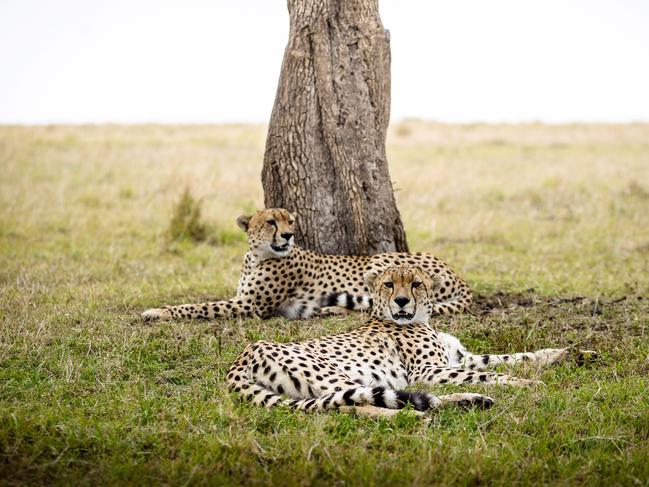
The most treasured moment? Maybe it’s parting the curtains of my suite alongside the swift-flowing Mara River in Kenya and spotting downstream a few smooth, large rocks, as they appear to be until attached hippo heads emerge from the murky depths to take in fresh air. The hippos have probably been napping, but they need to come up for a breather at least every five minutes.
Perhaps it’s an encounter with the last two northern white rhinos on Earth. Then again, think of the spectacle of umbrella-shaped acacia trees with even-taller majestic giraffes nibbling on their uppermost leaves, all set against a sinking orange sun. Or recall a safari lunch, savouring the vast scenery of the savanna grasslands of Kenya’s Masai Mara where they merge with the Serengeti of Tanzania.
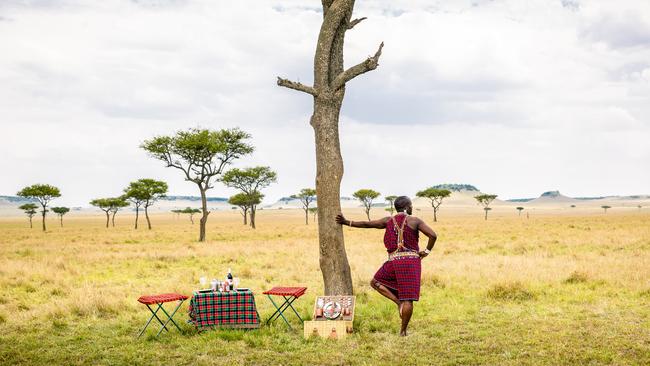
Not another human in sight, but keep watch in the tall grass for a big cat that may have an eye on you. Serene today, this is the territory across which a million or more wildebeest will migrate from this month in search of fresh oatgrass pastures. With them, half a million zebras and herds of gazelles; in their footsteps, lions and a parade of predators. Lying in wait at crossing points of the Mara, crocodiles. Locals are adamant we must return for this migratory spectacle.
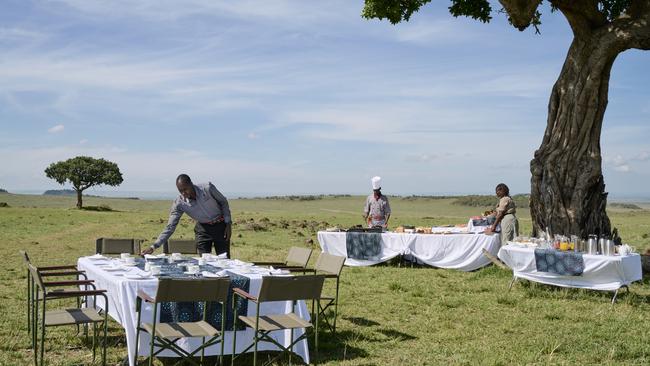
Yes, it’s my first African safari and, no, I can’t curb my enthusiasm. This is a transcendent experience.
I am travelling with luxury operator Abercrombie & Kent in a small group on a tour that takes us from Nairobi north by road to Ol Pejeta Conservancy and by Twin Otter aircraft south to the Masai Mara National Reserve.
What makes the trip special is our guide, Peter, who is warm, capable and knowledgeable. He can convey information about the wild animals we will be discovering – their feeding, breeding and social habits – and the vegetation and landscapes in an entertaining and memorable manner.
He has been with A&K for 26 years and worked in private enterprise and NGOs (Nairobi has a large UN presence), using multi-language skills picked up in a teaching stint in Japan, where he spent time with his uncle, a prize boxer. Our experience is enhanced, too, by the drivers of our open-sided LandCruisers, George and Anthony, who negotiate tracks in the game parks with panache.
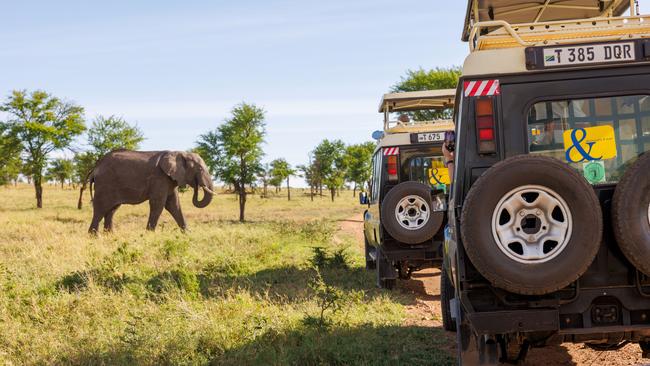
The safari comes in the wake of heavy rains, particularly in the Masai Mara, where floods have washed away bridges, damaged villages and annihilated visitor camps. As we head out mornings and late afternoons on hours-long game viewing drives, there’s slip-slidin’ in the mud but these drivers know their vehicles’ capabilities.
It is a joy to be in the grasslands, open and dense bush and by rivers and waterholes, spotting some animals instantly (and giraffes, elephants, buffaloes, zebras, rhinos and impalas are not hard to see), but watching the trained observers exercise their acute eyesight for the camouflaged creatures. Twitching rhino ears alert Peter to the presence of a leopard, birds screech an alarm, impalas pick up pace. We have nothing to do but wait and watch. Time is of no consequence.
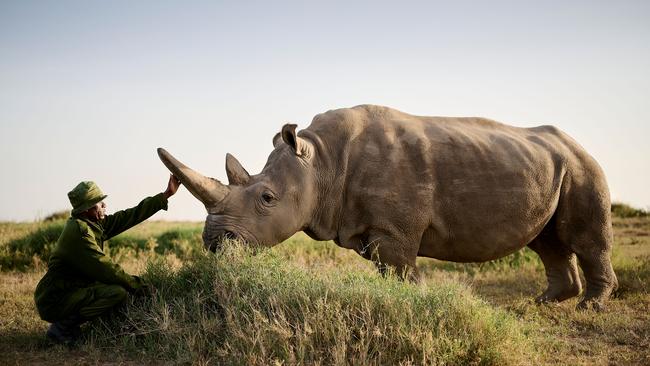
Ol Pejeta Conservancy is slap-bang on the Equator, at a cooling altitude of 1826m and within sight of snow-capped Mount Kenya, Africa’s second-highest peak after Kilimanjaro. Visitors can straddle the hemispheres on a concrete line running from an upright map of Africa, not far from the conservancy’s Rongai Gate. A signpost points to Sydney, 12,237km southeast. Ol Pejeta is a 365sq km former cattle property, once owned by notorious billionaire arms dealer Adnan Khashoggi, but now in the hands of a conservation not-for-profit. Fenced and heavily guarded, it has a transit corridor for migratory animals.
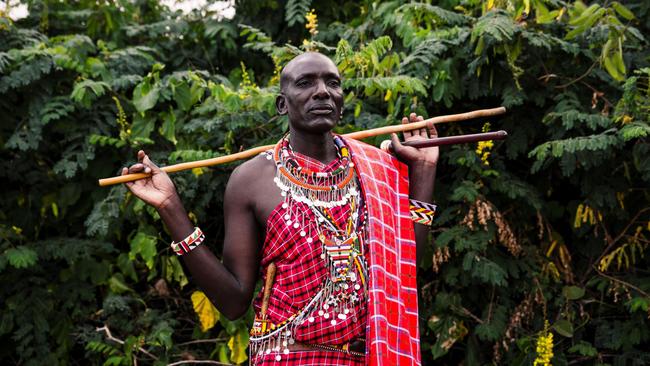
We are barely into the park before a crossing of zebras (my knowledge of animal group names comes from a helpful A&K guidebook) happen to really be crossing the LandCruiser’s path. And in short order, we spot a tower of giraffes, a crash of rhinos and a herd (or memory) of elephants.
The photographic hunt is on for the Big Five – lion, leopard, rhino, elephant and buffalo – but I have misgivings about the category. These were the most dangerous and prized assets a trophy hunter could kill. Over the next week, we will spot them all, the leopard being the most stealthy. Add in cheetahs, warthogs, hyenas, jackals, impalas and gazelles, monkeys of all types, ostriches, hippos and fearsome Nile crocodiles. In the air, a profusion of birdlife from vultures to crowned cranes and exquisite lilac breasted rollers.
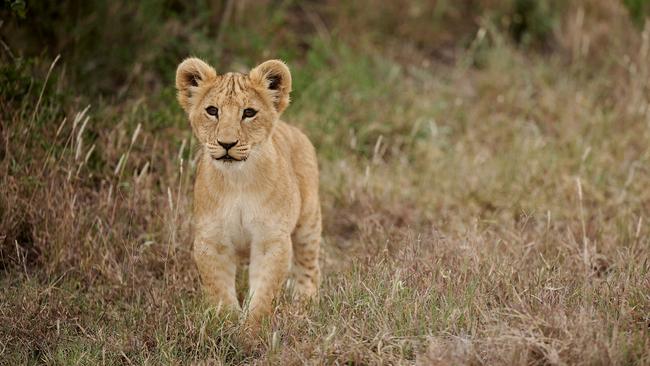
Ol Pejeta is tops for rhinos. As well as a sanctuary for about 160 critically endangered black rhinos, it is home to the last two surviving northern white rhinos, both female. Zoo-born Najin, 35, and her daughter, Fatu, 24, have a 300ha enclosure to wander, and IVF and stem cell therapy provide optimism that one day they may be joined by a calf.
Neither is capable of bearing offspring but hope lies with a subspecies cousin, a southern white rhino, to act as a surrogate mum for an embryo created from a Fatu egg. A team of anti-poaching pooches – trained bloodhounds and a spaniel – is on guard with armed rangers throughout the conservancy.
Peter’s casually dropped morsels of info enliven our drives. Rhinos have poor eyesight and can be temperamental. While reasonably sedentary, when riled they can run at 40km/h. Is that sleek cat in the grass a cheetah or leopard? Tear marks down a face define a cheetah. They’re not all that confrontational and fall prey to fellow predators. Leopards, with a smaller head, pull prey up a tree and are cannier.
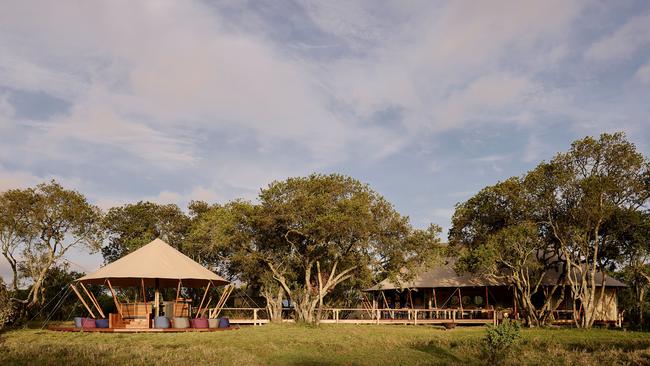
Those giraffes – 16 or more – over near a clump of acacias are 5.2m tall and have 45cm tongues to aid sky-high dining. They have a powerful kick and it would take a pride of lions to bring an adult down, but younger ones are vulnerable. How to tell a male from a female by looking up rather than down? The ossicones on the male head are bald on top and that comes from “necking”, which in this case means combat. So that charming tableau of two giraffes standing close with necks seemingly protruding from the one body may not be a loved-up couple.
Zebra stripes seem deceivingly uniform but have barcode-like differences, which their young learn early to “scan” to identify their mothers. And hyenas have a hierarchy with a royal family at the head. A group of eight can run down big animals; they may not be fast at 20km/h, but they are constant. After swooning over jackals, we later see two rip into a young impala while its mother laments. The circle of life can be vicious.
I love widow birds, trailing a black mourning cape, that rise and fall like helicopters. And the black-and-white marabou stork, affectionately known as Hilton doormen.
After each drive we have time to recap and refresh at our A&K lodges where meals are consistently top-notch, drinks complimentary and service without fault. Sanctuary Tambarare at Ol Pejeta is A&K’s newest offering, opened two years ago. With 10 luxury tents and a private villa, the view is towards a watering hole and Mount Kenya.
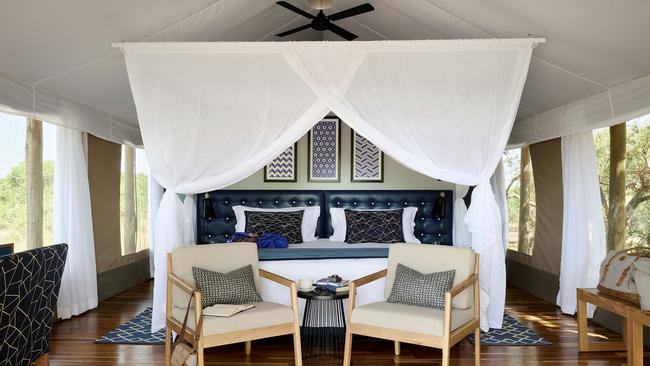
My bed is opulently large and netted; it adjoins a spacious bathroom with twin vanities. Decor is in smart navy and white tones and while the “tent” has a solid frame and timber flooring and deck, light rain by night falls soothingly on its canvas roof. Dress by all means for dinner, but the style is “safari informal” and luggage restrictions on our light aircraft flights demand wardrobe ingenuity over excess.

While not stinting on refinements, the Tambarare experience feels homely. We are farewelled by staff at a planting of a yellow-barked acacia in our name, encouraging a return.
After a flight to the Masai Mara, Sanctuary Olonana, which is A&K’s original lodge, is a relaunched property with the wow factor writ large. Fourteen pavilion-style suites line the Mara River. Mine, No.7 “Napishana”, has a rock exterior wall, reflecting the environment, and its timbers and furnishings are in muted greys and blues.
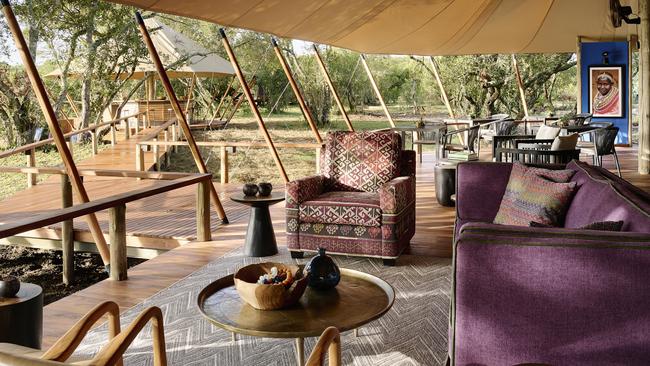
For nothing distracts from the sensational view, revealed through floor-to-ceiling glass, of the river, heading to Lake Victoria. Look at, and listen to, the Mara from the bedroom-dressing area, which opens to a sunken lounge with semicircular sofa and armchairs, and then to a deck with day bed.
The marble-and-slate bathroom is almost the size of the living area with a tub for a post-safari scrub and a triple-headed rain shower in a Garden of Eden setting.
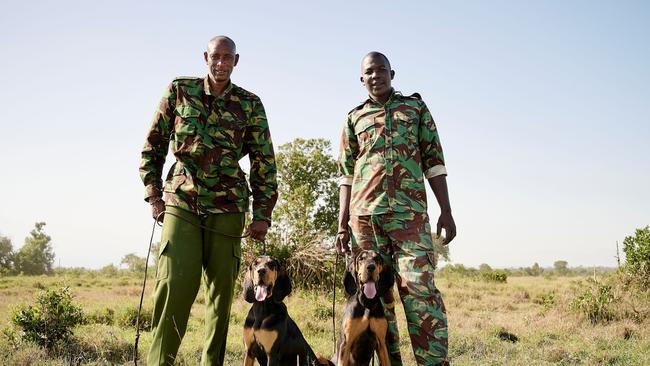
Dining is in the main lodge, which has an African art-decorated lounge area with fireplace and library. Add an open bar where a nightly Kenyan gin and tonic is the go.
On the menu look for a seafood curry, beef medallions, roast quail and Kenyan-inspired dishes. Nearby, a traditional Maasai (with a double “a” in the first syllable for the people) oval-shaped hut, made of mud and sticks with thatched roof, sells local craft, including exquisite beadwork, ceramics, blankets in vibrant pink and red checks, and decorated sticks to ward off predators.
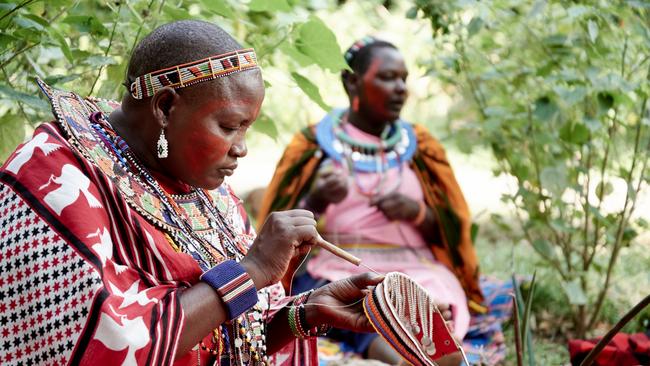
At the end of our Ol Pejeta stay, we are two short of the Big Five – a leopard and, surprisingly, a lion. As Peter says: “Because we are looking for a lion, everything looks like a lion.” But no luck. As he predicts, in the Masai Mara, and a short distance from the airstrip, we are in the realm of the Lion King, observing a male making an amorous but unsuccessful approach to a female.
As we leave for home, driver Anthony is a blaze of colour in his Maasai attire. He hopes we have enjoyed this visit to his backyard. It’s been the trip of a lifetime. How I long to hear again the cheerful Swahili greeting, “Jambo”.
More to the story
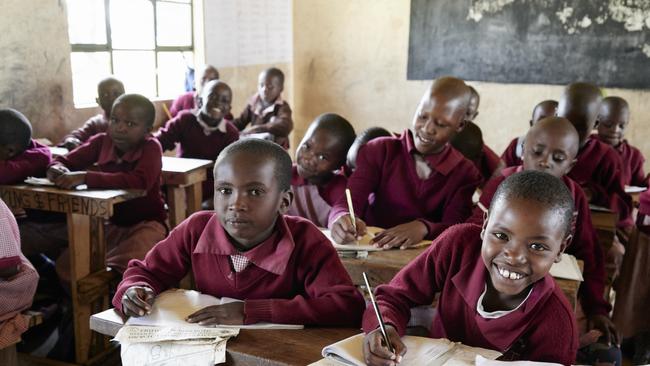
It’s lunchtime as we pull into Enkereri Primary School in the Masai Mara and the pupils in tomato-red uniforms are lining up for a lunch of rice and beans served hot from the kitchen. But first a choir, led by school founder Jacquie, sings songs of welcome. On display, a LifeStraw clean-water filter unit, installed by Abercrombie & Kent Philanthropy, a non-profit arm of A&K that funds projects with environmental and social aims, in consultation with local communities. It’s been an A&K commitment since 1982. The number of LifeStraw filters installed is heading up to 1000. They provide clean water for kids at school, who are able to take it home to their villages where the water source can be polluted.
In the know
The best months to view the Great Migration are July-October but this period can be busy. The main wet season is April-May with rains in November-December also. A&K conducts bespoke and small group tours throughout the world. A 10-day Classic Kenya trip includes a night in Nairobi, two nights at Tawi Lodge, Amboseli; three nights at Sanctuary Tambarare, Ol Pejeta; three nights at Sanctuary Olonana, Masai Mara. From $13,995 a person, twin-share, includes meals, beverages and game viewing activities.
Graham Erbacher was a guest of Abercrombie & Kent.
If you love to travel, sign up to our free weekly Travel + Luxury newsletter here.



To join the conversation, please log in. Don't have an account? Register
Join the conversation, you are commenting as Logout